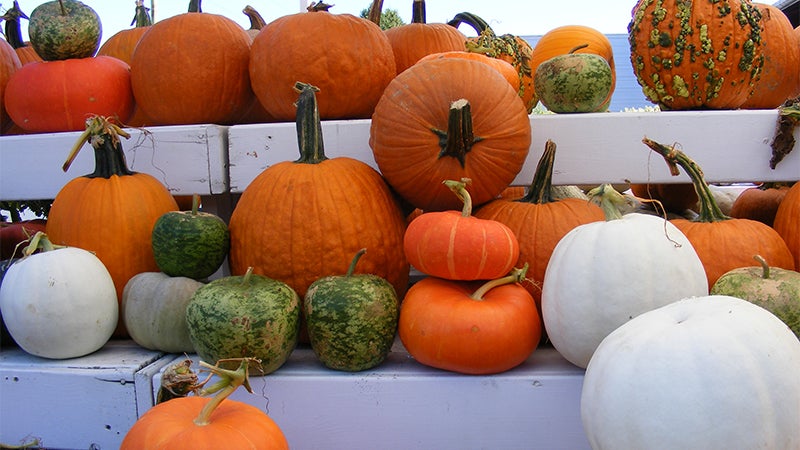The Pick of the Patch
Published 2:22 pm Monday, October 2, 2017
Pumpkin is plentiful this time of year and it is good in so many ways. It’s good for you nutritionally and it tastes good. Most of us think of pumpkin pie, but there are many other ways to add pumpkin to your menu: pumpkin soup, pumpkin muffins or pumpkin cookies.
A type of winter squash, pumpkins come in many sizes, from miniature varieties of one pound or less, to giant, prize-winning varieties of 300 to 400 pounds! The traditional round, deep-orange pumpkins used for carving jack-o’-lanterns on Halloween are not the best kind to use for cooking because they tend to be stringy and too moist. The small, dull orange, skinny variety called the sugar pumpkin has more pulp and is better to use for cooking.
The bright orange color of pumpkin is a dead giveaway that pumpkin is loaded with an important antioxidant, beta-carotene. Beta-carotene is one of the plant carotenoids converted to vitamin A in the body. In the conversion to vitamin A, beta-carotene performs many important functions in overall health.
Current research indicates that a diet rich in foods containing beta-carotene may reduce the risk of developing certain types of cancer and offers protection against heart disease. Beta-carotene offers protection against other diseases as well as some degenerative aspects of aging. Pumpkin seeds are a great source of protein, minerals, vitamins, and omega-3 fatty acids.
Pumpkins, in general, feature orange or yellow color; however, some varieties exhibit dark to pale green, brown, white, red or gray. Their color is largely influenced by yellow-orange pigments in their skin and pulp. Its thick rind is smooth with light, vertical ribs.
A good quality pumpkin will be hard and heavy for its size. Choose pumpkins that are firm, heavy, brightly colored, and free from blemishes. Avoid dull-colored pumpkins that have shriveled skin, soft spots, cuts, or breaks.
Some recipes, especially breads and muffins, call for cooked pumpkin.•
Jimmi Buell, Extension Agent, Family and Consumer Sciences, Polk County Center of the NC Cooperative Extension Service, teaches cooking and nutrition classes with a focus on improving health with better food choices. She can be reached at jimmi_buell@ncsu.edu or 828-894-8218.
How to cook a pumpkin
Step 1
Prepare the pumpkin for cooking.
Wash the exterior of the pumpkin in cool or warm water, no soap. Cut the pumpkin in half. A serrated knife and a sawing motion works best – a smooth knife is more likely to slip and hurt you! For a large pumpkin I’ve been known to use a handsaw (clean one, of course).
Step 2
Scrape the insides.
You want to get out that stringy, dangly stuff that coats the inside surface. I find a heavy ice cream scoop works great for this. Note: Save the seeds as they can be used either to plant pumpkins next year, or roasted to eat this year. Place them in a bowl of water and rub them between your hands. Then pick out the orange stringy guts (throw that away) and drain off the water. Spread them out on a clean towel or paper towel to dry and they’re ready to save for next year’s planting or roasting.
Step 3
Bake in the oven.
You can also bake the prepared pumpkin in the oven, just like a butternut squash. This method takes the longest. Basically, you cut and scoop out the pumpkin seeds, place it cut side down into an oven container (with lid) or baking sheet. Cover it and pop it in a 350 degree oven. It normally takes about 45 to 90 minutes, depending on the size of your pumpkin. Just test it periodically by sticking it with a fork to see if it is soft.
Step 4
Scoop out the cooked pumpkin.
Use the spoon to gently lift and scoop the cooked pumpkin out of the skin. It should separate easily and in fairly large chucks, if the pumpkin is cooked. Many times the skin or rind will simply lift off with your fingers. I’ll bet you didn’t realize making your own pumpkin glop… err, “puree” was this easy! Voila, you’re ready to add to your favorite recipe!
Creamy Pumpkin Soup
Here’s one of my favorite ways to use fresh pumpkin. No need to cook the pumpkin beforehand. Use fresh pumpkin and fall apples to make this low-fat creamy pumpkin soup that’s great for a first course or a light supper. Sprinkle with toasted pumpkin seeds, if desired.
Yields 5 servings (serving size 1 cup).
Ingredients
2 teaspoons stick margarine
1 cup chopped onion
3/4 teaspoon dried rubbed sage
1/2 teaspoon curry powder
1/4 teaspoon ground nutmeg
3 tablespoons all-purpose flour
3 (10 1/2-ounce) cans low-salt chicken broth
1 tablespoon tomato paste
1/4 teaspoon salt
3 cups cubed peeled fresh pumpkin (1 pound)
1 cup chopped peeled McIntosh or other sweet cooking apple
1/2 cup evaporated skim milk
Sage sprigs (optional)
Directions
Melt margarine in a Dutch oven over medium heat. Add onion; sauté 3 minutes. Add sage, curry powder, and nutmeg; cook 30 seconds. Stir in flour; cook 30 seconds. Add broth, tomato paste, and salt, stirring well with a whisk. Stir in pumpkin and apple; bring to a boil. Cover, reduce heat, and simmer 25 minutes or until pumpkin is tender, stirring occasionally. Remove from heat; cool slightly. Place mixture in a blender or food processor; process until smooth. Return mixture to Dutch oven; add milk. Cook until thoroughly heated. Garnish with sage sprigs, if desired.






